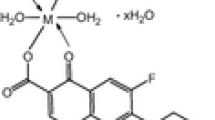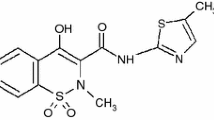Abstract
Ciprofloxacin (CPF, C17H18FN3O3) drug is used in the treatment of some bacterial infectious diseases. The drug was investigated using thermal analysis (TA) measurements (TG/DTG) and electron impact mass spectral (EI-MS) fragmentation at 70 eV techniques. Furthermore, the drug was characterized and investigated by other spectroscopic tools as IR, UV–Vis, 1H-, and 13C-NMR. Semi-empirical MO calculation using PM3 procedure has been carried out on neutral molecule and positively charged species. The calculations included, bond length, bond order, bond strain, partial charge distribution, ionization energy, and heat of formation (ΔH f). The PM3 procedure provides a basis for fine distinction among sites of initial bond cleavage, which is crucial to the rationalization of subsequent fragmentation of the molecule. The mass spectra and thermal analysis fragmentation pathways were proposed and compared to each other to select the most suitable scheme representing the correct fragmentation of this drug. From EI-MS, the main primary cleavage site of the charged molecule is that due to C–COOH bond cleavage with H-rearrangement to skeleton and CO2 loss which can further decompose by piperazine loss. Thermal analysis of the neutral form of the drug reveals the high response of the drug to the temperature variation with very fast rate. Thermal decomposition has carried out in several sequential steps in the temperature range 40–650 °C. The initial thermal decomposition is similar to that obtained by mass spectrometric fragmentation (C–COOH fragment) but differ in that a rearrangement occurs by OH and CO loss. Therefore, comparison between MS and TA helps in selection the proper pathway representing the fragmentation of this drug. This comparison successfully confirmed by MO calculation. Finally, the effect of fluorine atom on the stability of the drug was discussed.







Similar content being viewed by others
References
Nelson JM, Chiller TM, Powers JH, Angulo FJ. Fluoroquinolone-resistant Campylobacter species and the withdrawal of fluoroquinolones from use in poultry: a public health success story. Clin Infect Dis. 2007;4:977–80.
Alovero FL, Pan X-S, Morris JE, Manzo RH, Fisher LM. Engineering the specificity of antibacterial fluoroquinolones: benzenesulfonamide modifications at C-7 of ciprofloxacin change its primary target in Streptococcus pneumoniae from topoisomerase IV to gyrase. Antimicrob Agents Chemother. 2000;44(2):320–5.
Larsen BS, McEwen C, editors. Mass spectrometry of biological materials. 2nd ed. Revised and Expanded. New York: Marcel Dekker; 1998.
Levsen K. Progress in mass spectrometry, Vol. 4. Fundamental aspects of organic mass spectrometry. Weiheim, New York: Verlag Chemie; 1978.
Bourcier S, Hoppiliard Y. Fragmentation mechanisms of protonated benzylamines. Electrospray ionisation-tandem mass spectrometry study and ab initio molecular orbital calculations. Eur J Mass Spectrom. 2003;9:351–60.
Fahmey MA, Zayed MA, Keshek YH. Comparative study on the fragmentation of some simple phenolic compounds using mass spectrometry and thermal analyses. Thermochem Acta. 2001;366:183–8.
Fahmey MA, Zayed MA. Phenolic-iodine redox products: mass spectrometry, thermal and other physico-chemical methods of analyses. J Therm Anal Calorim. 2002;67:163–75.
Fahmey MA, Zayed MA, El-Shobaky HG. Study of some phenolic-iodine redox polymeric products by thermal analyses and mass spectrometry. J Therm Anal Calorim. 2005;82:137–42.
Somogyi A, Gomory A, Vekey K, Tamas J. Use of bond orders and valences for the description and prediction of primary fragmentation processes. Org Mass Spectrom. 1991;26:936–8.
Zayed MA, Fahmey MA, Hawash MF. Investigation of malonanilide and its dinitro-isomers using thermal analyses, mass spectrometry and semi-empirical MO calculation. Egypt J Chem. 2005;48:43–57.
Zayed MA, Fahmey MA, Hawash MF. Investigation of diazepam drug using thermal analyses, mass spectrometry and semi-empirical MO calculation. Spectrochim Acta A. 2005;61:799–805.
Zayed MA, Hawash MF, Fahmey MA. Structure investigation of codeine drug using mass spectrometry, thermal analyses and semi-emperical molecular orbital (MO) calculations. Spectrochim Acta A. 2006;64:363–71.
Zayed MA, Fahmey MA, Hawash MF, El-Habeeb AA. Mass spectrometric investigation of buspirone drug in comparison with thermal analyses and MO-calculations. Spectrochim Acta A. 2007;67:522–30.
Stewart JJP. Optimization of parameters for semi-empirical methods I. Method. J Comput Chem. 1989;10:209–20.
Baker J. An algorithm for the location of transition states. J Comput Chem. 1986;7:385–95.
Stewart JJP. Software package MOPAC 2000, Tokyo: Fujitsu Limited; 1999.
Milata V, Ilavsky D, Goljer I, Zalibera L. Thermal cyclocondensation of ethyl (1-methyl-5- and 6-benzimidazolyl/benzotriazolyl)aminomethylenepropanedioates. Collect Czech Chem Commun. 1994;59:1145–52.
Song C-H, Ryu H-W, Park J-K, Ko T-S. Mechanism of DNA gyrase inhibition by quinolones: I. Spectral analysis for nalidixic acid polymorphism. Bull Korean Chem Soc. 1999;20:727–30.
Milata V, Ilavsky D, Chudik M, Zalibera L, Lesko J, Seman M, Belicova A. Gould-Jacobs reaction of 6-amino-2, 3-diphenylquinoxaline. Mon Chem. 1995;126:1349–58.
Mazuel C. Norfloxacin. In: Florey K , editor. Analytical profiles of drugs substances. Vol. 20. San Diego: Academic press; 1991. p. 557–600.
Šuštar B, Bukovec N, Bukovec P. Polymorphism and stability of norfloxacin, (1-ethyl-6-fluoro-1, 4-dihydro-4-oxo-7-(1-piperazinil)-3-quinolinocarboxylic acid. J Therm Anal. 1993;40:475–81.
Zayed MA, Nour El-Dien FA, Hawash MF, Fahmey MA. Mass spectra of gliclazide drug at various ion sources temperature. Its thermal behavior and molecular orbital calculations. J Therm Anal. 2010;102:305–12.
Johnson PM, Zhu L. Mass analyzed threshold ionization: structural information for a mass spectrum and mass information for ionic spectroscopy. Int J Mass Spectrom Ion Process. 1994;131:193–209.
Cooks RG, Beynon JH, Caprioli RM, Laster GR. Metastable ions. Amsterdam: Elsevier; 1973. p. ix–296.
Author information
Authors and Affiliations
Corresponding author
Rights and permissions
About this article
Cite this article
El-Gamel, N.E.A., Hawash, M.F. & Fahmey, M.A. Structure characterization and spectroscopic investigation of ciprofloxacin drug. J Therm Anal Calorim 108, 253–262 (2012). https://doi.org/10.1007/s10973-011-1584-8
Received:
Accepted:
Published:
Issue Date:
DOI: https://doi.org/10.1007/s10973-011-1584-8




